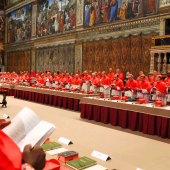New AI partnership with Vatican brings St. Peter's Basilica closer to a global audience
On November 11, 2024, the Vatican and Microsoft unveiled an innovative AI-powered digital portal, 'St. Peter’s Basilica: AI-Enhanced Experience,' designed to offer users an immersive journey into the iconic basilica.
This digital initiative allows virtual visitors to experience the grandeur of St. Peter’s Basilica from anywhere in the world, making it accessible to people who may never have the chance to visit Rome in person.
In partnership with Microsoft and Iconem, a heritage digitization company, the Vatican has created a detailed virtual replica of St. Peter’s Basilica. This experience leverages AI and cutting-edge digital imaging technology to capture the intricate beauty of the Basilica in unprecedented detail.
As the Church looks forward to the 2025 Jubilee, the project offers virtual tours and in-depth digital exhibits, enabling global audiences to experience the Basilica as never before.
Cardinal Mauro Gambetti, Archpriest of St. Peter’s Basilica, expressed his enthusiasm for the project, likening it to gazing at a “starry sky on a summer night.”
He highlighted how this digital initiative acts as a "telescope" for viewing the Basilica more vividly and closely than ever.
Microsoft President Brad Smith praised the partnership as a unique blend of modern technology and ancient heritage, enhancing the spiritual experience for pilgrims.
“Just going through it myself gave me even more insight into Saint Peter’s legacy and what he stood for,” Smith said.
The virtual tours reveal hidden areas, such as Roman tombs beneath the Basilica and intricate artwork in the high dome, which are now accessible through the AI-powered portal.
The initiative used drones, high-resolution cameras, and laser scanning to create a faithful digital representation of St. Peter’s Basilica. Advanced AI algorithms then processed this data, making the Basilica accessible in a format resonating with a new generation.
Smith reflected on the broader significance of this project, calling it a testament to what different perspectives can achieve together.
"There’s a story here about what people can accomplish together when they build on each other's strengths and bring out the best in each other,” he said. He hopes this initiative will inspire greater collaboration and understanding.
Addressing potential concerns that technology and faith might clash, Smith emphasized that this project demonstrates how new tools can advance faith and heritage rather than conflict with them.
He said, “So often, one assumes that new technology is in tension with faith, but this project shows a way to eliminate that tension, creating opportunities for people to achieve something bigger than they might have imagined.”
This partnership stands as a powerful example of how technology can deepen appreciation for cultural and spiritual heritage, bridging the past and present to inspire a global audience.
With inputs from Vatican News
Radio Veritas Asia (RVA), a media platform of the Catholic Church, aims to share Christ. RVA started in 1969 as a continental Catholic radio station to serve Asian countries in their respective local language, thus earning the tag “the Voice of Asian Christianity.” Responding to the emerging context, RVA embraced media platforms to connect with the global Asian audience via its 21 language websites and various social media platforms.

















- Reply
Permalink